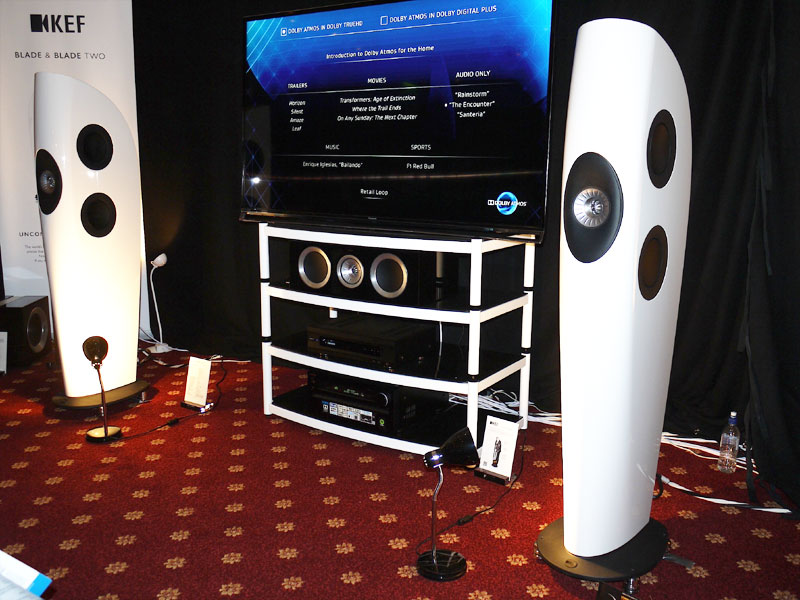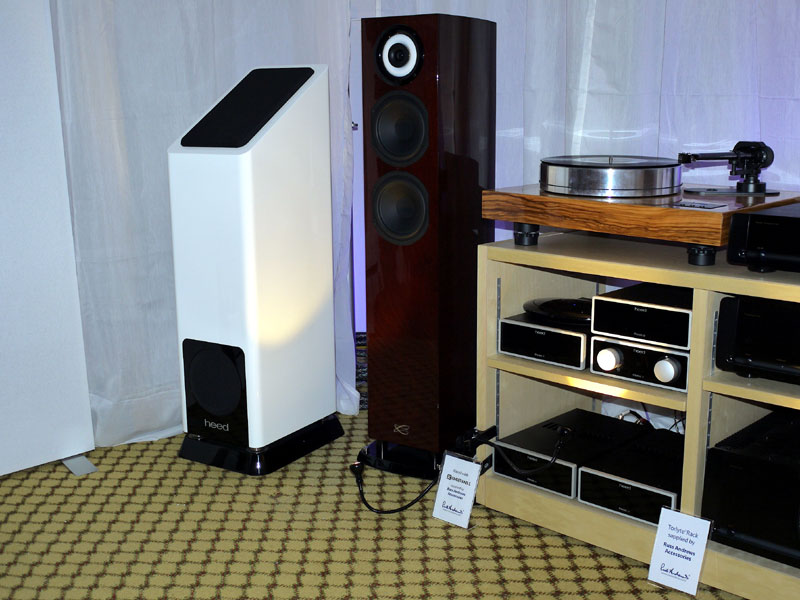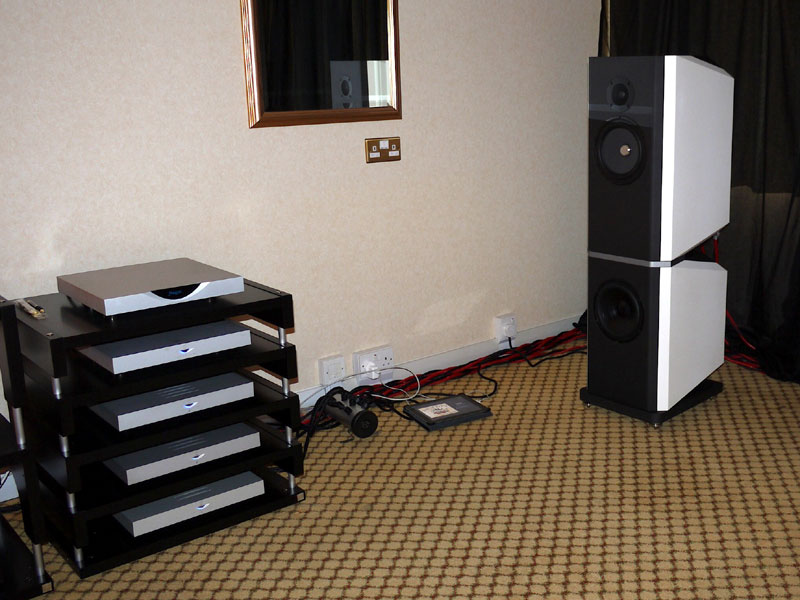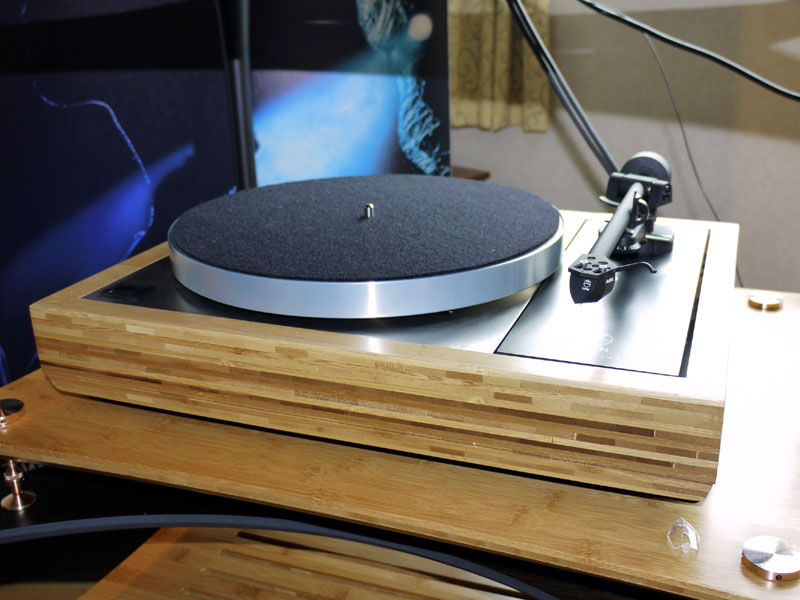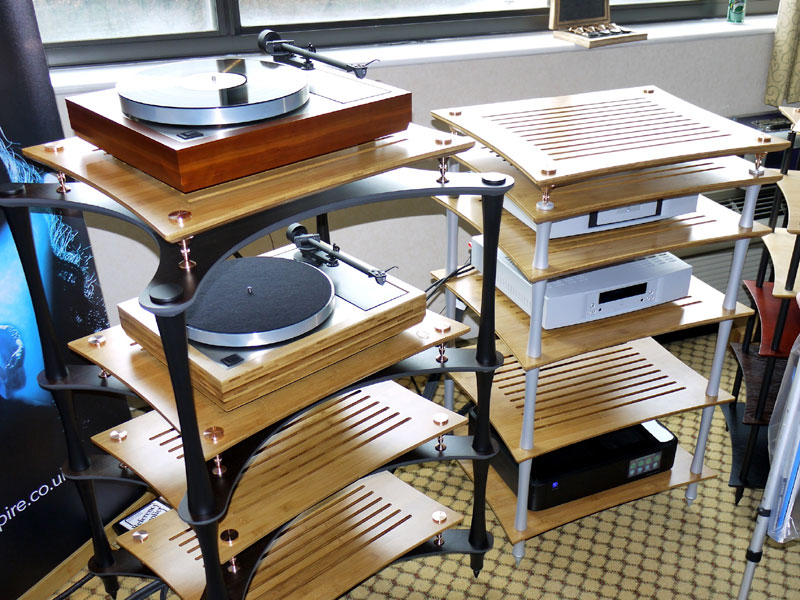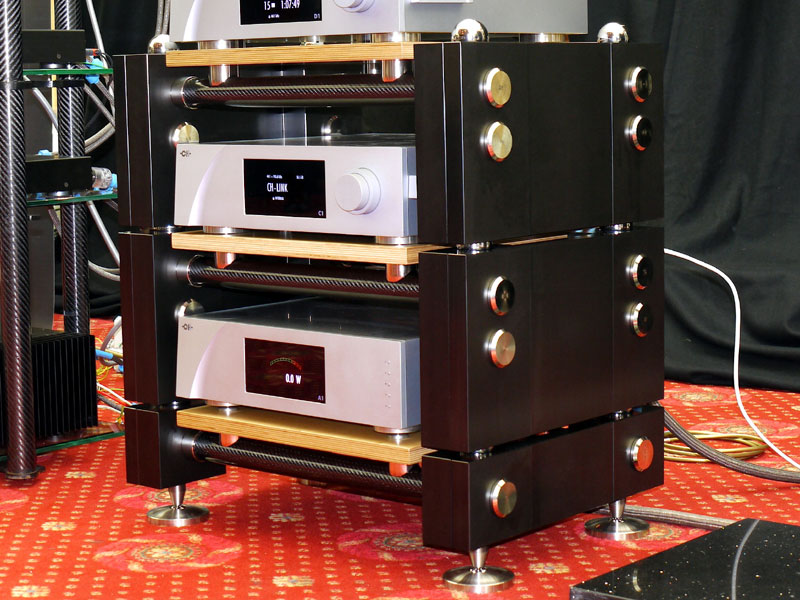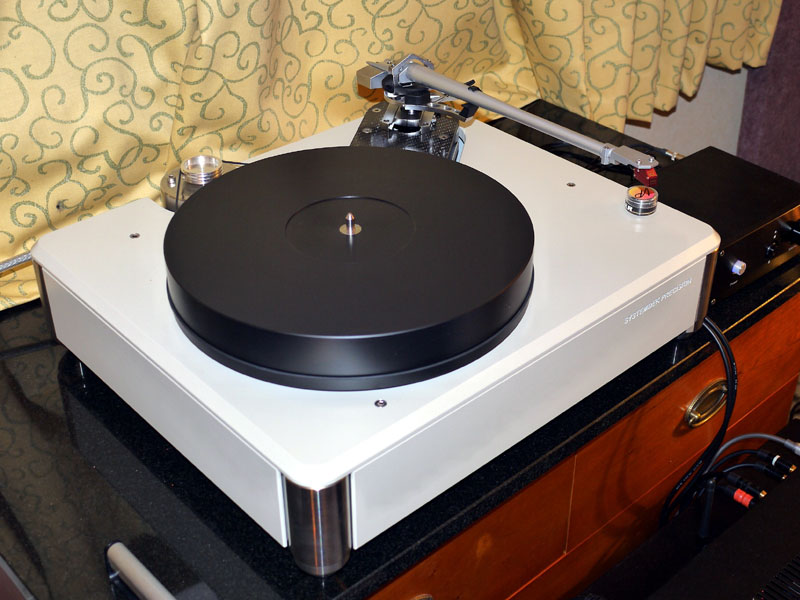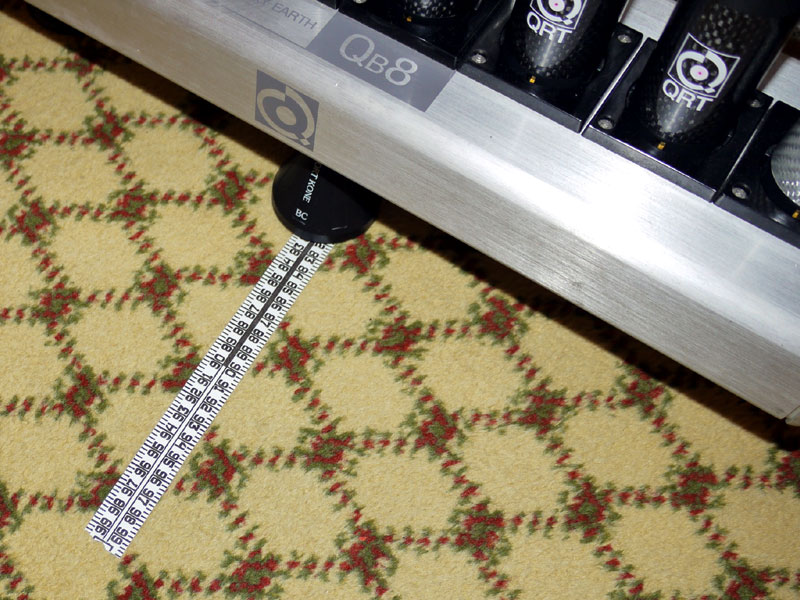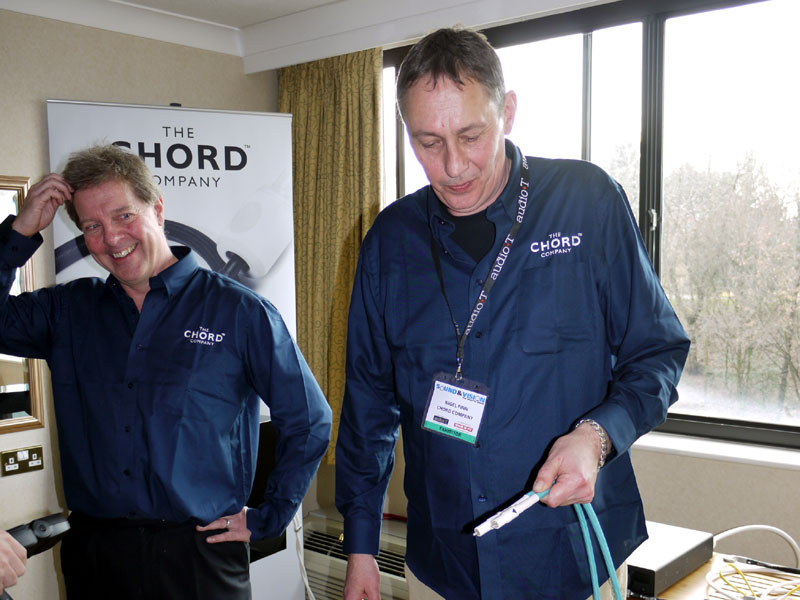Sound & Vision 2015 • Way Out West
s anybody familiar with the Sound & Vision Show, aka the Bristol Show, will attest, it’s an event with a difference, a specific character that derives from its very nature. Unlike most audio shows, it is organized by and (therefore, naturally) for the benefit of one of the UK’s major dealer networks. Changes in the UK hi-fi landscape mean that the Audio T group (with 14 stores spread across the country) dominates the UK middle market and that increasingly -- and not surprisingly -- the exhibitors at the show in turn reflect the stores’ stock profile. But not exclusively. Other members of the middle market also come out to play, reflecting that the Bristol Show -- teetering on the brink of its 30th birthday -- is by far the UK’s longest-running and best-attended show (both in terms of exhibitors and visitors), a fact also reflected in its sponsorship by What Hi-Fi?, a "buying-guide" magazine with a circulation that dwarfs all the other audio print titles put together. One thing that you can guarantee is that you’ll see more five-star products under one roof in Bristol than anywhere else in the UK, a fact clearly appreciated by the long lines that form before opening time on each of its three days. However, that and the show’s timing in late February, roughly six weeks after CES, also mean that those visitors won’t be exposed to the sort of extravagant, state-of-the-art, cost-no-object rigs that are such a feature of shows like the Rocky Mountain Audio Fest in Denver or High End in Munich. With so many major product launches targeted on Las Vegas, it’s hardly surprising that relatively few companies use Bristol as a launch platform, while the Audio T stock profile barely touches the lower reaches of the high end, meaning that the major international distributors and their products are also absent. By way of comparison, I didn’t see a single two-channel system at Bristol that topped out beyond the £100,000 mark -- a figure that wouldn’t buy the cables in plenty of the systems at the CES or RMAF. Of course, you could easily argue that this just makes the whole event more relevant, but it should also set the expectation levels of press and public alike. Having said that, the show still represented the first public outing for at least three significant new products: the Naim NAC N-272 DAC/preamp, the upmarket Arcam A49 integrated amp (and its C49/P49 preamp/power derivatives) -- both already covered by separate news stories -- and the eagerly anticipated KEF Blade 2, first seen, like the Arcam, in Munich last year. While the ambitious engineering and aggressive pricing of the A49 has already been covered in depth, this was my first opportunity to hear the amps in action, with both the integrated and the pre/power combo on parade. Paired with the matching FMJ CDS27 (£800 -- used as a transport) and D33 DAC (£2200), the C49 and a pair of bridged P49 amps made light work of driving a pair of the three-way, stand-mounted KEF Reference 1s (£4500/pair). Mind you, with around a kilowatt on tap into the KEF’s 4-ohm load, that’s hardly surprising and helps support designer John Dawson’s contention that his motivation in building the 49-series amps was having something to drive the (notoriously awkward) KEF Blades properly. The sound was super quick, clean, dynamically uninhibited and musically unobstructive, giving the sense of a set of amplifiers that want to pass the signal through as quickly as possible by getting as far out of the way as possible -- a trait reminiscent of the big Jeff Rowland amplifiers, which is quite a compliment given the Arcams’ relatively approachable pricing (£3750 for the A49, £2750 for the C49 and £3000 for the bridgeable stereo power amp). Bob Marley’s "One Love" was suitably fluid, with deep and almost physically mobile bass, natural, expressive vocals and blindingly fast percussion. On this showing the US-built class-G designs should offer seriously impressive performance and value for the money. As long as potential customers can appreciate that the Arcam badge, a novelty at this price point, is actually a genuine benefit that brings economies of scale and considerable engineering experience, then a good few audiophiles might well reap the rewards. Having said that, it’s a challenge that has defeated brands as big as Honda -- remember the original NSX super car? -- so it will be interesting to see if they can hear past Arcam’s value-for-money/solid middle-market brand image.
Talking of KEF brings me to the Blade 2 (£16,000/pair in black or white, with colors costing around £2000 more) as well as one of the show’s more interesting trends. Despite the fact that the Audio T stores don’t stock the brand, KEF speakers were present in no fewer than nine different systems/rooms -- amongst them some of the most musically rewarding setups at the show. As well as KEF’s own room, where you could hear the Blade 2s as well as a Dolby-Atmos-enabled system based on the R-series speakers, Chord Electronics, Yamaha, Arcam, The Chord Company, Nordost, Pioneer and two Onkyo rooms all featured the company’s products, with the new Reference range being particularly evident. On home turf, they chose to partner the Blade 2s with a full suite of Simaudio Moon Evolution electronics -- a 650D CD transport/DAC (£7100), 740P preamp (£7750) and 860A amplifier (£11,150). Besides the disc player, they also employed a VPI Prime turntable (£3750) mounting an NOS Kiseki Blue (for which the price is irrelevant unless you’ve already got one, in which case you know what it is -- which is another way of saying they’s all gone) feeding the 650LP phono stage (£5650) and MacBook Pro running JRiver for file replay. Cables were Studio Connections and the rack a Quadraspire SVT with Bronze Upgrade. The Blade 2s are virtually indistinguishable from their larger brothers, the smaller sideways-firing woofers being the only giveaway if the two speakers aren’t standing side by side. The similarities run way more than skin deep, with the 2s (stood on Track Audio feet) exhibiting the same remarkable coherence as the original together with tight, deep bass and impressive dynamics, which at the price makes them a very interesting proposition indeed. Time will tell whether they are any easier to drive than the bigger model, but being slightly shorter and shallower they’ll definitely be easier to accommodate. With the Blade 2 being in a constant state of back order, don’t expect a review anytime soon.
Another new speaker making impressive sounds was the Heed Envoy. With an estimated UK retail price of £10,000/pair, this is a larger three-way version of the extremely interesting two-way Enigma that is currently under review. The new flagship uses the same acutely angled top baffle and quarter-wave loading, although in this instance an upgraded soft-dome tweeter is matched to a pair of the same 6 1/4" Morel bass units, each with its own differentially loaded termination. The second bass driver is mounted low in the front baffle, with the large cabinet and all those internal dividers helping to account for each speaker’s significant 90-pound mass. Driving system comprised a Heed Thesis Alpha preamp (£2650) and Thesis Phi phono stage (£1600), both fed from a Thesis Pi twin power supply (£1500), with Thesis Omega monoblocks doing the driving (£2100 each). A full suite of Kimber Select cables, a Russ Andrews BMU3000 balanced-mode AC power supply and Torlyte supports delivered the necessary system infrastructure. Source was a Pro-Ject Xtension 12 turntable carrying Heed’s own Benz Micro-built Zene cartridge (£700). The system produced a sound that was notably airy, fluid, unforced and expressive, yet still managed to retain a sense of rhythmic snap and muscular drive, again underlining the persuasive and entertaining nature of this company’s unusual products. The sound of this system was genuinely seductive, echoing and extending the familiar performance attributes of the Enigma loudspeaker. In the same room it was a pleasure to see a full complement of Parasound’s high-end Halo electronics, including the JC3+ (£3500), JC2 BP preamp (£4700) and A21 amplifier (£2400), fed from the same Pro-Ject ‘table as well as a Cabasse Stream Source and driving the Cabasse Aegea 3 loudspeakers. Previously the Parasound importer has tended to focus on the installation and multichannel markets, starving budget-conscious UK audiophiles of the brand’s fascinating two-channel offerings. Hopefully this signals a very welcome change of heart.
The Kudos Titan 808 represented another impressive introduction. Like the Heed Envoy, the pair at the show is the only one currently in existence, so plenty of details remain to be fixed before it reaches series production -- like the final price. The current estimate is between £20K and £25K, making it roughly twice the price of its T88 predecessor, but looking at the complexity of the construction, material content and versatility incorporated into the design, that still looks like impressive value. The big news here is the option to run the Titan 808 in passive mode, active or active with a DSP crossover, employing Linn’s Exact technology. Designed to compensate for nonlinearities in the drivers and eliminate time and phase errors in the crossover, the Exact is similar in approach and effect to Goldmund’s extremely impressive Proteus Technology, the end result of its Project Leonardo. By keeping the signal in the digital domain as long as possible, system designers can eliminate losses associated with analog signal transfer as well as take advantage of powerful DSP technology to correct for mechanical or electrical noise and distortions in the hardware. Goldmund take the path to its logical extreme: building DACs into their power amplifier inputs, totally eliminating analog cables from the low-level signal path. The Linn Klimax Exactbox doesn’t go quite that far, but by providing analog outputs it is arguably more versatile and provides an easier upgrade path, allowing the use of conventional amplifiers from other companies. Needless to say, the system used in Bristol employed an all-Linn electronics package, a Klimax Exact streamer (£10,000), Klimax Exactbox crossover (£10,000) and three Klimax Twin stereo power amps ((£8000 each). Amusingly (at least for UK audiophiles of a certain age), the source was a Naim HDX server, while the electronics were sited on your correspondent’s preferred Hutter racks, no coincidence as the company also builds the Titan cabinets. The sound in the small bedroom was remarkably clean, linear and suitably seamless, the music completely divorced from both the large speaker cabinets and unfortunate room interactions. It was neutral (in the best sense of that often abused term) and dynamic, with natural tonality and impressive musical agility and intent. Quick on its feet and responsive, it allowed the listener direct access to the players and their performance, effectively removing the system from the equation. Passive crossovers really are the root of all evil in audio, but using digital electronics to eliminate them isn’t a guaranteed panacea: As demonstrated by the vast majority of digital room correction systems and digital subwoofer crossovers, the cure can often be worse than the disease. That’s what made the Goldmund systems so impressive in the first place. Now, Linn have matched that performance and rendered the technology more user-friendly and affordable. Okay, so the Exact setup and three amps will still strain most budgets, but the results with the Kudos Titan 808 should give many heavily invested audiophiles pause for thought. This was in many important respects the most impressive sound at the show. Kudos to Kudos for taking the plunge and incorporating the Exact technology into not just their Titan 808 flagship but the next two models down as well. Both the Cardea Super 10 stand-mount and Super 20 floorstander are two-way designs, with the 20 coming in at well under the £5000 mark. Suddenly a Kudos Exact system seems almost affordable! If it can get close to matching the coherence of the Titan 808s, then it should be a serious contender.
While on the subject of Linn, I would be remiss not to mention the Booplinth, another entry into the LP12 upgrade stakes. What makes this one different from all the other fancy hardwood offerings out there? Well, for a start it comes from the irrepressible Brian Morris, a man so thoroughly committed to all things Linn that he wears gloves to handle products from other companies. Well, I could be joking, but together with current business partner Trevor, they were once lynchpins of the Linn sales and marketing team. Still totally committed to Linn’s products, they run Brian And Trevor’s House of Hi-Fi, a dealer with a difference -- although that’s a longer story for another day. One of the key brands they work with is Quadraspire, and they were so impressed with the sonic advantages when the company first introduced their bamboo shelves that they approached them about developing a bamboo plinth for the LP12. After many iterations, the result is the Booplinth you see before you -- or at least in the picture. Unlike most of the replacement plinths on offer, which are essentially cosmetic variations or "upgrades," the Booplinth’s raison d’Ítre is entirely sonic (although it is available in cherry, ebony and black as well as the natural finish shown). On top of the well-reported benefits of bamboo’s rigid yet dispersive mechanical nature, the Booplinth is machined from a single block, eliminating the mitered or butted joints used in all other slab-to-slab constructions, further reducing the plinth’s resonant signature. Given Brian and Trevor’s fanatical attention to detail when it comes to all things Linn, it should come as no surprise that the LP12’s mechanical parts fit directly into the Booplinth, a process that’s included in the £1650 price if you buy it from B&T. Of course, if you are not within range of sunny Manchester, then you’ll need a local Linn dealer to do that part for you. I’m sufficiently intrigued by this one to pay a visit to the House Of Hi-Fi and hear the demonstration. If you can’t wait that long, there’s more information here.
Quadraspire themselves were showing their new X Reference rack. Having developed the Bronze Upgrade parts for the Q4 and SVT racks -- short adjustable spike kits machined from (you guessed it) solid bronze that fit between the standard rack’s top shelf and its uprights, creating a mechanically decoupled arrangement in place of the usual clamped one -- the company was so impressed with the results that they looked for a way of incorporating the sonic benefits into all levels of a rack without compromising its stability. The X Reference is possibly best understood as a larger space-frame that will allow the SVT shelves to stand within its footprint, each one decoupled using the bronze spikes and supported by bronze cups inserted into a radically cutaway, almost X-shaped element, also machined from bamboo but without the SVT shelf’s slots. Instead, a central cutout maintains the air-flow benefits of the SVT design. The good news is that because the X Reference uses standard SVT shelves, it keeps the rack system modular and upgradeable, so owners of existing SVT racks can carry their existing shelves over and save some cash. The bad news is that the same doesn’t apply to the uprights. To keep things rigid with the wider footprint, Quadraspire have increased the diameter of the elegantly waisted uprights to 44mm (from 32mm on the standard SVT). Of course, with the added height of the Bronze Upgrade parts eating into your vertical spacing, you might well need new taller uprights anyway. Price of the X Reference rack is £1000 per level, quite a step up from the standard SVT, but then Quadraspire claim quite a step up in performance too. That drops to £870 a level if you’ve got existing shelves, but it’s only worth carrying those over if they are of the bamboo variety.
If the X Reference constitutes a serious step up in price for the Quadraspire brand, it only just reaches the likely starting price of the new rack shown by Wilson Benesch. I’m guessing here, because the final parts came straight off the CNC machine and into the van just as its doors were slamming shut for departure to the show -- so final pricing, shelf-material options and design details all remain to be fixed. But what was at the show was seriously interesting, not least because for once a rack design has gotten the problem the right way up from the word go, focusing on draining energy out of the equipment rather than putting the major effort into isolating it. The rack structure rests its shelves on carbon-fiber tubes, using reduced-contact-area stainless-steel couplers. The carbon cross members (each capable of supporting 250 tons in compression, despite their seven-ounce weight) are held under considerable tension by individually tuned steel rods, creating a direct energy path or cascade into the substantial blocks at either end, machined from ecologically friendly structural POC. The rack system is modular and stackable, with decoupling gaskets between layers. The double bosses on the outer face are there to allow some adjustment of vertical spacing, but in production I’d expect to see a range of different-height end blocks. If the rack’s feet look familiar that’s because they’re based on the ones used on the Cardinal and Endeavour speakers. While this early prototype employed simple plywood shelves, with the CH Precision electronics directly coupled to them using their own mechanical grounding spikes, expect to see a range of shelf options, possibly starting with bamboo and then working up through different composites, along with matching couplers to interface with the supported equipment. The Wilson Benesch rack is the product of necessity: as UK distributors of the incredibly heavy CH Precision electronics, they needed something to support them. Well, necessity is the mother of invention, and it’s remarkable what you can do with a CNC shop and access to the latest materials technology. So it wasn’t in the plan and it’s so new it doesn’t have a name or even preliminary pricing, but one thing it does have is huge potential. I’ll be watching this one with considerable interest.
Meanwhile, the other, other Scottish turntable manufacturer has been quietly beavering away. Following on from their 3D Reference and Signature models, Bristol saw the first UK outing of the new Systemdek Precision (£14,000), originally launched in Munich last year. Like it’s bigger brothers it is a three-point-suspended, belt-drive design. It shares many of their other features too, albeit in slimmed down form -- not that you’d notice given the 99-pound weight. The motor is housed separately in its own stainless-steel pod. The machined Delrin subchassis is mass loaded to help produce a stable, low-frequency suspension system tuned to around 3Hz. The main bearing is a magnetically opposed, oil-bath design, immersing a 20mm shaft in a well machined from solid PTFE. The standing bearing supports a 50mm-thick platter, also machined from Delrin. The two-speed external power supply uses a digitally generated 50Hz waveform and is built into its own machined-from-solid housing. The carbon-fiber armboard can accept 'arms up to 12" in effective length, the model at the show mounting an SME 312-S and a van den Hul MC Two cartridge, although the all-silver combination might not be to everybody’s taste. Personally speaking, I’d have gone with a black 'arm, but either way there’s no denying that this is a handsome beast.
Which brings me to what were for me the two most interesting things at the show. First, a simple product that’s so blindingly obvious it makes you wonder why it’s taken so long for someone to come up with it. Not that anybody was actually selling it at the show. Oh, no -- this product was actually in use. Nordost were putting on their normal comparative presentations, but short of the recent revisions to the QB8 distribution block (which now has a 20A IEC input) there was little news to report, as the company keeps its powder dry for Munich in May. Which is when I spotted the tape that Bjorn Bengtsson had been using during the system setup: sticking tape with measurements printed on it -- genius! Anybody who has read any of our articles regarding speaker setup or attended any of our seminars at shows will know that we are serial abusers of masking tape, using it extensively as a setup tool and placement guide. Anybody who has looked closer than that will have seen the Sharpie markings on that tape, painstakingly dividing it into individual centimeters and half centimeters. Well, no more -- no more imprecisely scrawled graduations, no more groveling around on the floor, no more aching knees, no more peering about myopically in near darkness at nearly illegible scrawlings. Apparently Bjorn picked up the tape in the US on a recent visit -- and hasn’t looked back. The clean, white surface with crisp black printing is brilliantly legible, and if the sample in the picture looks cluttered, there are plenty of alternatives, in a variety of widths, measured off in modern metric units or those olde worlde inches and with linear scales or centered graduations. You can add additional indications or notes with a contrasting colored felt-tip pen, and even wipe them off if you choose a board marker. Stickier than low-tack tape, but not as stubbornly sticky as some masking tapes, it shouldn’t leave residue or present removal problems, although according to Bjorn sometimes it fragments rather than coming off in a single clean strip. Apparently developed for use by CSI technicians recording crime scenes, I can think of no better application than restoring poorly setup speakers to proper placement -- that’s a crime worth solving! You can view the range of available options and get your own supply at www.oregonruleco.com. Finally, how often can you say that the most interesting product you heard at the show was a cable, or even a range of cables? The "it all sounds the same" cable nay-sayers out there are going to hate this, but then they wouldn’t bother to listen anyway -- because they know that cables can’t make a difference. Except that The Chord Company, longtime suppliers of sensibly priced cables to the audiophile masses, were demonstrating that actually they do. Indeed, they were demonstrating that, contrary to all received wisdom (at least in certain quarters), not only do cables make a difference, but that the differences they make are so audible and so musically important that you’d have to be deaf or in denial not to hear them. Of course, that’s not exactly news and other cable companies like Nordost have been doing just that for years. But what made the Chord presentation so interesting were not just the sonic and musical differences between the cables they were playing, but the physical differences that produced them. Their first area of exploration was network cabling -- otherwise known as Ethernet cables (although Chord were keen to stress that their cables don’t actually adhere to the strict Ethernet standard, hence their chosen terminology) -- a core component of any server-or network-based replay system. Using a system built around a Melco NAS drive, Linn Klimax streamer and Bonnec amplification driving KEF Reference 1 loudspeakers, all fed from a Bonnec AC distribution unit and wired throughout with their flagship Sarum Tuned ARAY cables, they started by comparing a standard Ethernet cable between the Melco and the Klimax to their own C-Stream (£45), a cable that offers enhanced shielding and tighter-fitting plugs. The difference was far from subtle, with more apparent bandwidth, air and color, as well as greater separation, space and far clearer rhythmic patterns and phrasing. You can ignore this if you want -- or deny that it’s important or even that it happens -- but if you do and you run Ethernet in your system, you are throwing away serious musical benefits, benefits that only get bigger as you move further up the range. Next contender was the Anthem network cable. Significantly more expensive at £450 for the first terminated meter length, part of its USP is that subsequent meters only cost £50, making it a cost-effective option for longer runs. The cable itself uses carefully chosen insulation materials to create a hard/soft/hard sandwich skin that Chord have found to offer superior mechanical properties, in combination with the best available connectors, hand-terminated by Chord themselves. The difference here was really significant, with improved resolution, texture, tonal shadings and a natural expressive range that brought vocals and handclaps to life. Musical communication was much more convincing and direct, with the cable bringing body, dimensionality and subtle dynamic shifts to the mix. At this point we diverted to hear just what happens when you replace the standard Power Chord AC cable (£175) with the new Signature version (£500) featuring silver-plated conductors, a basic implementation of the company’s ARAY mechanical tuning and their own UK 13A plug design. The answer is increased dynamic range, a more positively planted sense of pace and timing, greater fluidity and a much more emphatic presentation. That was followed by the current Sarum Tuned ARAY power cord (£1250), which although it brought a nicely relaxed and expressive quality to the presentation, actually lacked the temporal authority of the Signature. Which brought us to the point of this little diversion -- the new Super ARAY AC cable (£1700). This combines the new 13A plug of the Signature with the basic design of the Sarum Tuned ARAY conductors, but with a different and far more effective approach to the mechanical tuning. Predictably, the step up in musical quality was far from subtle, with a richer tonal palette, greater depth and space but most significantly, a far more grasp of rhythmic sophistication, contrast and ensemble playing. The band just sounded tighter, like better players on a real roll. But, of course, power cords can’t make a difference. Any scientist will tell you that! Which brings us back to network cable and two more offerings, the Signature (£750) and Sarum Super ARAY (£1900), both of which include the Super ARAY mechanical tuning -- and both of which extend performance way beyond the already impressive Anthem. Interestingly, whilst the more expensive cable offered seriously worthwhile musical benefits over the Signature, both of these cables were cut from the same sonic stock. They were characterized by their natural tonality, sense of weight, body and musical flow, the coherence with which they presented the phenomenal detail they passed, the naturally articulate and expressive quality they brought to the performance as a whole. If a better system sounds more like people, then both these cables moved this system significantly closer to reality. Having been totally convinced of the virtues of the new Super ARAY tuning, the best news is that it’s retrofittable, with any Sarum Tuned ARAY interconnect or speaker cable upgradeable to the new Super ARAY standard. Form an orderly queue, please. Given the torrent of online abuse that AudioQuest has received for daring to launch an $11,000 network cable -- a cable that according to certain "experts" cannot possibly make any sonic difference -- the Chord Company presentation was both fascinating and timely. It was also utterly convincing. As I said, if you couldn’t hear the differences between these network cables you either weren’t listening or you are in denial. The rest of us will be only too happy to enjoy the considerable musical benefits.
But we’re not quite done yet. The final card up Chord’s sleeve, a comparison between the new Sarum Super ARAY interconnect (£1900/meter pair) and a new flagship design, dubbed simply Chord Music and weighing in at £3000 -- an unheard of sum for a Chord product, yet comparatively modest in the world of high end cables. What made this particular comparison so interesting was that the cables were essentially identical, at least in terms of conductors, topology, contacts and mechanical tuning. The only difference is that the Chord Music interconnects used a new, proprietary dielectric dubbed Taylon by Chord (in the absence of any established brand name from the manufacturer) and had PTFE sleeves on the RCA plugs in place of the acrylic ones used on the Sarum. Beyond that, Alan Gibb and Nigel Finn, the Chord Company’s very own chuckle brothers, weren’t prepared to say a word, their lips sealed by confidentiality agreements and the threat of dire consequences if they should divulge militarily sensitive information. Reputedly, they also agreed not to employ the technology in the production of chemical, nuclear or biological weapons. Lucky us! Yada, yada, yada -- we’ve all heard variations on that theme plenty of times before. The real question is, how much difference can a bit of insulation and some plug covers actually make? After all, they don’t even pass the signal! Oh, dear. As I said, all those "they all sound the same" merchants won’t be happy. As big and musically important as the differences between the various network cables had been, as dramatic as the increase in dynamic range and rhythmic authority were with the power cords, the difference between the Sarum Super ARAY and the Chord Music interconnects was by far the largest and fundamentally most important difference demonstrated. This wasn’t a change; it was a transformation. I could point to the added body, weight, color, separation and harmonic development. I could flag up the added sense of drive, pace, attack and overall musical impetus. I should mention the increase in articulation and how much more natural the vocal delivery suddenly seemed. But all of these individual attributes seemed trivial in comparison to their collective impact, their effect on the performance as a whole. You could hear deeper into the mix; suddenly you could tell not just what was being played but why, how it drove the track and how it all fitted together; rhythmic patterns and structure fell into place; there was a new clarity and purpose to the performance which brought it right into the room. The whole thing just made a lot more sense -- and in this case it was Led Zeppelin doing the playing! The ability of the cable to project the sheer power and energy of the band, as well as sort out the recording so that you could hear exactly who was doing what, was remarkable. What was more remarkable was that the Sarum Super ARAY is no slouch, the Tuned ARAY version regarded as both an excellent performer and excellent value. Yet the Chord Music left it well and truly in the weeds: more natural, greater clarity, better communication and far less aurally "visible," the new cable just sounded right. Given that the album being played was Houses of the Holy, that’s no mean feat! Even more interestingly, apparently that’s the way it sounds pretty much from new, which given the extended break-in times for PTFE-insulated cables is another plus. For anybody who has worked with or listened to a lot of
different cables, a lot of this will come as no surprise. Mechanical behavior and
connector characteristics have been the cable insiders’ hot topic for a while now.
The importance of dielectric materials is hardly news; that’s why manufacturers go to
such lengths to remove as much of it as possible from direct contact with the conductors
in their designs, from foaming it to constructing complex cradle arrangements. In extreme
cases (Cogan-Hall springs to mind) they attempt to remove it altogether. But what was
surprising was just how large and clearly defined the differences were, particularly
between the network cables, which reinforces the old adage about the increasing importance
of each system element the closer it gets to the source. Likewise, both the network cables
and the power cords really rammed home the importance of connectors and mechanical
considerations when it comes to cable design. But the really big news is that PTFE, the
dielectric of choice for the last two decades is finally starting to show its age. The
king might not be dead yet, but long live Taylon! Now, all we have to do is find out
exactly what on earth it is. Oh, and don’t tell the "scientists." |

